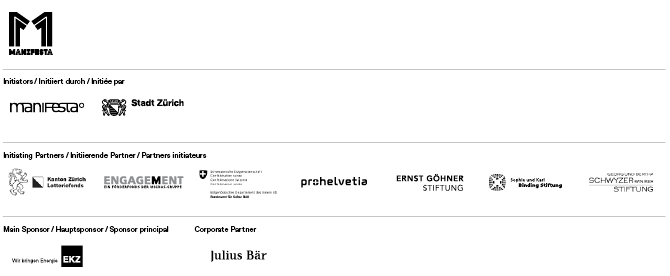What People Do for Money: Some Joint Ventures
June 9–September 18, 2016
In just over two months, on June 11, 2016, Manifesta 11 opens its doors in Zurich under the title What People Do for Money: Some Joint Ventures. Preparations for the international art exhibition are now in full motion: the new productions, that are arising between international artists and Zurich professionals of other professions, are getting more and more concrete. What do I do for money? Do I earn enough to survive? Human working conditions are the focus of the curatorial concept drawn up by German artist Christian Jankowski for Manifesta 11. In this 11th edition of Manifesta, the European Biennial of Contemporary Art, a total of about 250 existing and 30 newly commissioned works will be presented in more than 35 venues all over the city of Zurich for more than 100 days.
Accreditation for press, professionals and Art Basel visitors now online here.
Each edition of Manifesta reacts to the diversity of social, political and geographical conditions in today’s Europe. Since the first Manifesta in Rotterdam 20 years ago, Manifesta always emphasises critical thought, scientific research and artistic experimentation. Hedwig Fijen, Manifesta director: “A Manifesta in Switzerland, a country with a system of direct democracy, a high standard of living and an isolationist foreign policy and said to have an almost idyllic character, can feel quite surreal in a time at which Europe is confronted with the most dramatic humanitarian crisis since the Second World War.” She adds that at the same time, “this Manifesta draws its reason and purpose from just that discrepancy.”
Manifesta 11 Curatorial Concept of Artists and Hosts
30 international artists are collaborating on projects with “hosts” of their choice. The results of these encounters will be exhibited at the professional hosts’ respective workplaces or at the main Manifesta exhibition venues in well-known Zurich institutions such as the Migros Museum für Gegenwartskunst, LUMA Westbau/POOL, Kunsthalle Zurich and Helmhaus. For example, the Catalan artist Carles Congost is collaborating with the Zurich Fire Brigade to reflect in his film Simply the best how feelings can alternate between passion and wage work. Maurizio Cattelan is working with a Paralympic athlete, Teresa Margolles with a transsexual sex worker, Marguerite Humeau with an engineer, and Shelly Nadashi with a literature teacher. The 30 participating artists also include the French writer Michel Houellebecq, who has joined forces with a doctor and invites Manifesta visitors to attend a meticulous check-up of his body. You can find the complete list of artists here.
Manifesta 11 Historical Section
The 30 artistic projects are flanked by a reflective selection of artworks under the title The Historical Exhibitions: Sites Under Construction with over a hundred positions. Developed by Manifesta curator Christian Jankowski along with Francesca Gavin, it examines and explores the various modes of artistic portrayal of current and historic working worlds.
Manifesta 11 Pavillon of Reflections
Centerpiece of Manifesta 11 will be the Pavillon of Reflections, a floating platform erected on Lake Zurich. Here, visitors will be able to witness crucial moments in the creation of the artworks as captured in a series of movie productions. Curator Christian Jankowski about the project: “In the daytime, the Pavillon of Reflections will function as an urban island, a meeting place and open-air swimming area, while at night it will turn into an open-air cinema.”
Manifesta 11 Cabaret der Künstler—Zunfthaus Voltaire
The traditional guilds of Zurich inspired Christian Jankowski for the concept of Manifesta 11. In conjunction with Manifesta 11, Zurich’s 27th trade, the guild of artists, was founded in March 2016. For this purpose, the entire historical building at Spiegelgasse 1 will be converted into a guild house from June 2016. Admission to the Cabaret der Künstler—Zunfthaus Voltaire is reserved for guild members only. Artists are called on to hand in proposals for guild membership with performances realized in conjunction with non-artists.
Manifesta 11 Mediation Programme
Manifesta aims to better understand contemporary art and the role it can play in society. With every edition of Manifesta, the education department has played a central role in the conception of the biennial. This Manifesta will be no exception: the mediation team has developed an education programme which focuses on the question of how participation can contribute to generating a heterogeneous art audience.
Manifesta 11 Publications
Manifesta 11’s catalogue What People Do for Money will place the hosts centre stage in addition to including new texts by Franco Berardi, Harald Falckenberg, Aaron Moulton, Sally O’Reilly, Mikhail Shishkin and Jakob Tanner. The bilingual (German/English) catalogue will be published by Lars Müller Publishers.The Manifesta 11 Guide book is a handy and indispensable companion to those visiting the biennial and Zurich. It includes all works of art and venues at a glance, a map and additional information about the artists.


